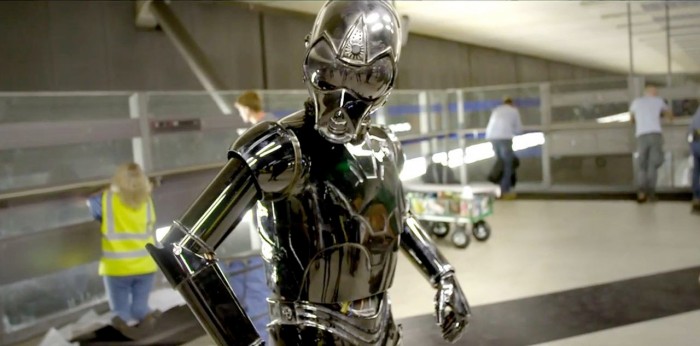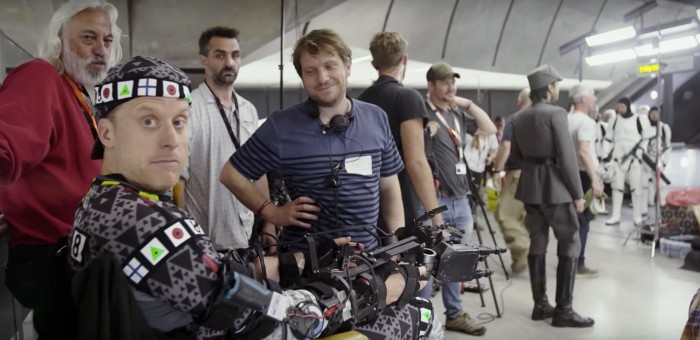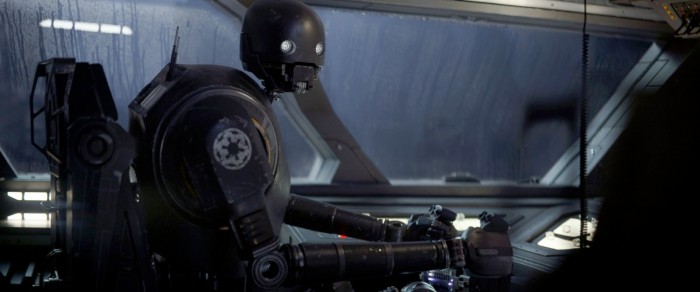'Rogue One' Interview: Alan Tudyk & ILM's Hal Hickel Talk The Creation & Performance Of K-2SO
This week brought Rogue One: A Star Wars Story to Blu-ray and DVD, allowing fans to bring home the first Star Wars spin-off home to watch over and over again with the added bonus of finally being able to watch Star Wars: A new Hope right after.
Besides that, you're likely going to be rewatching all of the scenes with K-2SO on repeat, since he stole so many scenes from his human counterparts. That's thanks to actor Alan Tudyk (A Knight's Tale, Wreck-It Ralph, Firefly), who not only provided the voice of the reprogrammed Imperial droid, but also did the motion capture performance on set with the rest of the actors.
We had a chance to sit down with Alan Tudyk along with Industrial Light and Magic animation supervisor Hal Hickel to talk about how they brought K-2SO to life, from his inception, to finding his voice, to figuring out his movement and more. We ran part of this interview regarding the original journey K-2SO had in earlier drafts of Rogue One, but this is the full Alan Tudyk interview with insight from Hal Hickel along with it.
 I wanted to walk about the inception of K-2SO, because I believe there was some concept art floating around that show him as one of the silver Imperial droids that we saw in the original trilogy, right?
I wanted to walk about the inception of K-2SO, because I believe there was some concept art floating around that show him as one of the silver Imperial droids that we saw in the original trilogy, right?
Hal Hickel: Hmmm. I don't know. I haven't seen that. I'm not doubting you. It may well be because there was a lot of exploration early on. I have to say the first artwork I saw is pretty much what he ended up looking like. But by that time the art department had already done a lot of exploration with Gareth [Edwards]. He had already honed in on something, and I never went and back and trolled through all the other versions they discarded, so I don't doubt that there's some version of him like that out there. I just haven't seen it myself.
As always happens, there was tons on exploration under Doug Chiang in the art department. Once they started to narrow it down then Neal Scanlan's group over in the UK, the creature shop, got to work doing a three foot maquette clay sculpture and a head study. Eventually they built, like a fiberglass – I don't know what it was made out out – full size version of him painted and everything, before we even started doing our CG version.
When did Alan come into the equation? Was he at the top of your list to voice him and do the motion capture?
Alan Tudyk: That was Gareth. I talked to Gareth at some point, was asked Skype with him, and didn't really take it very seriously. It was at a friend's house, "Hey, can I use your iPad, I gotta talk to this guy." I thought he was asking me, since I had done I, Robot, that's how I took it. Not that he was interested in me in the role, just that I would talk to him about how it would work. I had a very frank conversation with him. He'd be like, "Well I want every movement, every twitch of the eye, and even if it's a bad take, the mistake is what's true, and so I want that on camera." And I was like, "Why the hell are you gonna do that? A mistake on camera 'cause it's true?! This is bullshit. Man, get the best take you can but definitely get it. Just make sure you're on the actor. Don't abandon him." I was just letting it all hang out at my buddy's house like, "Listen, you're a nice guy but you gotta figure it out."
Then he asked me to audition. Gave me some pages that don't exist in the movie. It was an early version of the movie, or it was just an audition scene. They sometimes just give you a scene with an idea. It was about me landing on a planet and the magnetic fields fried this robot's brain, K-2SO's brain. He was buzz [slow-motion voice] slowing down and then [fast speed voice] picking up – it was putting you through the paces, what can you do with this? I did that, my wife taped it, or recorded it on her iPad, sent it off. Then Gareth came to town for Star Wars Celebration Anaheim and said he wants to meet you just to talk. Then he gave me the role there in the room. It was mental.
What was your process as far as developing the voice for K-2So? You're a very talented voice actor with an insane range. There have been so many times when I've found out that you voiced a role that I wasn't aware of while watching, and it blows me away. So how do you hone in on that character?
Alan Tudyk: I had three ideas for it. I didn't know what Gareth wanted, so I said I was gonna do this three ways, that audition scene. Once with just my voice like this, which didn't sound right at all. And then one with a more – it's called Mid-Atlantic speech, which I learned at Juilliard – it's what Sonny the robot sounds like in I, Robot. Just proper speech. Then I did an English accent which became K2. I liked the idea of that because he was in the Empire. There are so many English accents within droids, C-3PO for sure, and the Empire has an English accent a lot in it. So that's what I wanted to do, and luckily Gareth was like, "Absolutely, let's do that." That was pretty much it. Basically, they wanted the Mid-Atlantic speech of English. That proper way of speaking if you were programmed how to speak, that's how he speaks.
Hal Hickel: I like the Peter Falk version that didn't make it into.
Alan Tudyk: Ah! I wish I could do Peter Falk. [Indiscernible Peter Falk-esque mumbling]
He's got one sort of wonky eye...
Alan Tudyk Yeah, yeah!
On the next page, we talk about the advancement of motion capture technology and how Alan Tudyk and Hal Hickel figured out how much movement K-2SO should have and how much of a human vibe he should give off with his personality.
 You've done motion capture since the technology was still a new part of filmmaking, so how is it as an actor seeing it advance? And even in your department, Hal, can you talk about how it's gotten better or made things easier?
You've done motion capture since the technology was still a new part of filmmaking, so how is it as an actor seeing it advance? And even in your department, Hal, can you talk about how it's gotten better or made things easier?
Alan Tudyk: The differences are in post. Though there was a thing they did during I, Robot that I wish people weren't able to see, but I saw it online somewhere not too long ago. After we shot the whole movie, and shot it pretty much like [Rogue One] where I would be on set just in a suit, there was stuff that they cut that they had to do all this technical stuff that added at least a month to the production. But I had to go in and try to recreate all my physical motion, but on a motion capture stage. It was madness. Ugh. It was terrible. I'll just say that, it was terrible.
Movement has emotion. That's what dance is for God's sake, and also beautiful movement. There's emotion in movement. There's a story being told. Luckily because [ILM] is so good and that suit is so freeing and free, I was able to capture the stuff on set, the emotion, with the actors there. It was just baked into what was happening.
Hal Hickel: We've been doing the on set motion capture thing since the second Pirates of the Caribbean film, we started doing it. We needed to have Bill Nighy on set playing that role, not on a motion capture stage months later. We've done it on lots of films since then, and this one was a perfect use of it. We really wanted Alan there with Felicity [Jones] and Diego [Luna] on set, and he needed to be the height that he needed to be at, so we had to develop these stilts so that all the eye lines were correct. But the main thing is just to A) put him where he needs to be to do his job, which is one set, and B) get out of everybody's way so we don't have a lot of technical apparatus and procedures that are gonna slow down shooting and get in everybody's way. Then down the road, when they've selected the takes they want and they've edited the scene, they give it to us, our job is to just preserve what Alan did and not break it.
You mentioned that moving has emotion, it informs the character, so how difficult is it to hold back some of that emotion when you're playing a character like K-2SO, who isn't human? One of my favorite parts in Rogue One is when he has the line about probability where he says, "It's high," and he has this subtle movement that feels human, but it's not quite there. How do you figure out where the line is between human and non-human so you don't cross it?
Alan Tudyk: I don't know That was me. Like, that was human, in that I just did that on one of the last takes. It might have been on the last take. [In K-2SO's voice] "It's high. It's high." That's something I do, is that motion. "Look, let me just tell ya..." I think once you put it into a robot, that sort of helps it along to sort of – that robot has so much room to play that it can take a lot – there's that line where I slap Diego and I say, "There's a fresh one if you mouth off again." How is that possible? I just think the robot himself can do a lot. He's also kind of like somebody who is emotionally stunted. They're kinda of trapped in a young person's body, who's just very dry. [In K-2SO's voice] "It's nice to see that you're all blending in so well. Good thing I didn't come down here." It's smart ass.
Hal Hickel: We also made some decisions when he was being designed early on – when you look at C-3PO and the way Anthony Daniels moves, some of that has to do with the limitations of the suit. There's these little pistons on the arms that make it impossible for him to straighten his arms. They're always at least slightly bent.
Alan Tudyk: What crappy pistons! Can I just say... [laughs]
Hal Hickel: [Laughs] And there are limitations to how much he can bend his knee. His walk is particular because of that. So there's a lot of stuff that Anthony Daniels came up with for the character. But there's stuff that's sort of imposed by the suit. So when we're designing K2, there was a lot of discussion to make it feel like Star Wars, should we design him in a way that limits his movement. Or should he just be completely free.
Alan Tudyk: Thank God, you didn't.
Hal Hickel: And if we do that, is it not going to feel like Star Wars. At the end of the day we said, he's an enforcer droid. The point of him is to be able to fight and be agile and move quickly. It doesn't make sense for him to have things that are gonna – if he can't even raise his arm above his head or something. That was just part of the design thing. Then once [Alan] came on to our stage to try him on, [he] had his process of figuring out, "Should I be robotic? Should I not be? How much should I swing my arms?"
Alan Tudyk: Right, that's right. Swinging the arms was a thing. If you swung his arms to much it was like [sings Stayin' Alive] "You can tell by the way I use my walk..." It was immediately like Saturday Night Fever.
[Everyone laughs] We know that K-2SO sadly meets his demise in Rogue One, but we've seen shots of you on the beach with the rest of the Rebel crew. So what was the original path of K-2SO? What did he do on the beach –
We know that K-2SO sadly meets his demise in Rogue One, but we've seen shots of you on the beach with the rest of the Rebel crew. So what was the original path of K-2SO? What did he do on the beach –
Hal Hickel: No, no. That never happened. [Motions to recorder] Turn that off. [Laughs]
Alan Tudyk: As it was, we went into the building, the base, and then we never came out; I never came out. But we moved from the base to [another] base. We had to travel. So we had to be part of that war. The good thing about that was I got to go to the Maldives. Then also, I got to be part of a battle, which was so cool.
This is how they shoot things in Star Wars. We're running down a beach where there's explosions. This was built actually in London. There's all these troops, all these Alliance troops. They have a ship on a crane coming over us with that monkey dude on that gun on the side going 'Ahhhh! Ahhh!', screaming and shooting. It flies over us, touches down almost. Things are going ksh-ksh, blowing smoke out of the bottom as it touches down. Troops unload from either side, hub-hub, they join the flight. We're still running while this is happening. Guys are next to me getting launched. The stuntmen are – explosions – and launching in the air, jumping with cables pulling them up. Oh my God! If you wanna play Star Wars battle – while we're running towards there's Stormtroopers – like the best version of playing Star Wars, you could never have come up with this. Because I think it was $1.5 million just to do that one thing. Oh my God, it was so cool.
And then it got cut.
Alan Tudyk: All cut, but who gives a shit?
Hal Hickel: Piece of that shot are in the film. That thing still lands and guys jump out of it. When the camera swung around, and there's Cassian and Jyn – it cuts before that moment now, because you guys never made it back out.
So basically you start at one base, run across the beach go to another base, and then you still die there.
Alan Tudyk: I died right before I get inside.
Hal Hickel: The citadel, the building where they get the plans, used to be a separate building from the communications tower. So they used to have to get the plans, get out of the building, make their way to the communications tower as a group, and that ended up changing. That was really the main thing that changed.
